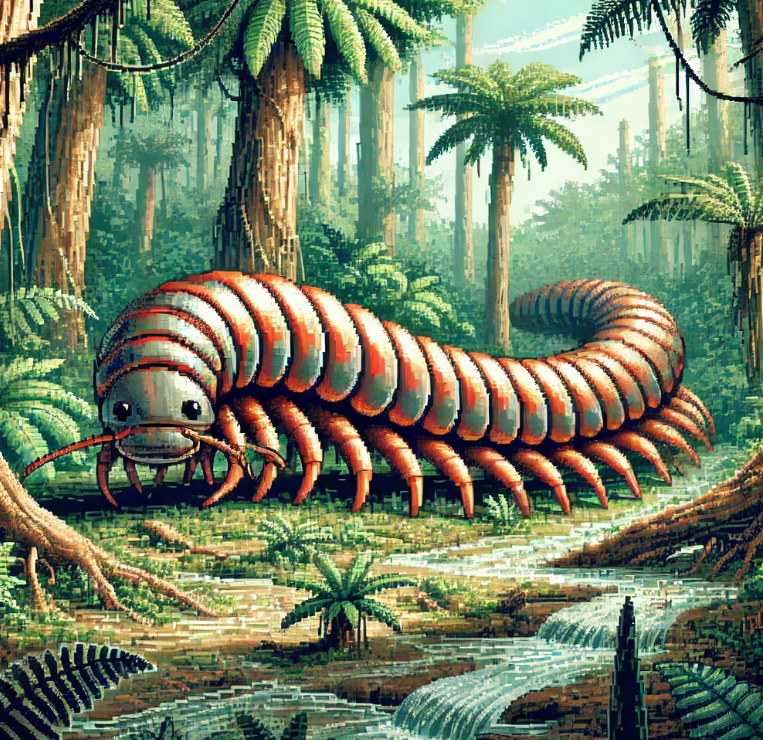
The Biggest Bug
The Astonishing World of Arthropleura
Imagine stumbling upon a creature longer than a modern human, crawling through dense prehistoric forests. This was no ordinary bug—it was Arthropleura, the largest arthropod that ever existed, a millipede-like giant that roamed the Earth over 300 million years ago. While fossils have long hinted at its immense size, the recent discovery of exceptionally well-preserved Arthropleura specimens is giving us our clearest look yet at this ancient titan, uncovering its secrets in ways we never thought possible.
The Largest Bug Ever
Stretching up to 8 feet long, Arthropleura is famous for its record-breaking size, making it the biggest arthropod—think of creatures like spiders and crabs—that has ever walked the planet.
Let’s linger on that for a second. Eight feet. This guy could dunk!
For millions of years, it dominated the lush, tropical forests of the Carboniferous period, a time when the Earth was warm and oxygen levels were much higher than today. But despite its impressive presence, our understanding of Arthropleura has been surprisingly limited. Most fossil finds were incomplete, often just fragments of its massive body.
However, recent advances in technology, particularly micro-computed tomography (CT scanning), have allowed scientists to peer deeper into these fossils than ever before. These CT scans, similar to what doctors use to see inside our bodies, have revealed the intricate details of Arthropleura‘s head, mouthparts, and even parts of its digestive system. These new findings not only paint a more complete picture of Arthropleura’s anatomy but also shed light on its place in the evolutionary tree of life.
A Mix of Millipede and Centipede
One of the most exciting discoveries about Arthropleura is how it blends features of both millipedes and centipedes. If you’ve ever seen a millipede slowly crawling across the ground or a centipede darting away when disturbed, you can imagine a creature that combines elements of both. The CT scans revealed that while Arthropleura likely had two pairs of legs per body segment—just like millipedes—it also had certain head structures, such as small leg-like maxillae, more typical of centipedes. This peculiar mix of characteristics has led scientists to place Arthropleura somewhere between these two groups on the evolutionary tree.
But what does this all mean for us today? It reminds us that nature often doesn’t fit into neat categories. Like a puzzle piece connecting different evolutionary groups, Arthropleura helps scientists better understand how millipedes and centipedes evolved, as well as the fascinating ways life can adapt and change over millions of years.
How Did It Get So Big?
The size of Arthropleura is nothing short of extraordinary, but how did it grow to be so massive? The answer lies in the unique conditions of its time. During the Carboniferous period, oxygen levels in the atmosphere were much higher than today—about 35% compared to the current 21%. This abundance of oxygen likely allowed arthropods like Arthropleura to grow to gigantic proportions. In a world full of dense, swampy forests and little competition from large predators, these colossal bugs thrived.
But as Earth’s climate shifted and oxygen levels dropped, creatures like Arthropleura faded from the scene. By the time the Permian period rolled around, these giant arthropods had disappeared, leaving behind only fossilized clues of their existence.
A Gentle Giant?
With such a massive size, you might expect Arthropleura to have been a fearsome predator, but the evidence suggests otherwise. Unlike today’s centipedes, which use venom to hunt their prey, Arthropleura didn’t have the same sharp, venomous fangs. In fact, it seems to have lacked the predatory adaptations that would make it a hunter. Instead, scientists believe it was a peaceful herbivore, munching on decaying plant material as it slowly lumbered through the forests. Imagine this giant, crawling through ferns and ancient trees, living its life as nature’s recycler.
This discovery changes how we view these ancient ecosystems. Rather than picturing a terrifying, carnivorous bug dominating the prehistoric landscape, we can now appreciate Arthropleura as a crucial player in breaking down and recycling organic material, much like earthworms do in today’s gardens.
The Technology Behind the Discovery
So, how did we uncover these amazing details? It all comes down to micro–CT scanning, a cutting-edge technology that allows scientists to examine fossils in three dimensions without damaging them. By using this technique, researchers were able to see inside Arthropleura fossils from Montceau-les-Mines in France, revealing structures that had never been seen before. These scans provided a detailed look at its head, including antennae and mouthparts, which are essential for understanding how this creature interacted with its environment.
The scans also offered insights into the arrangement of its legs and body segments, helping scientists piece together how Arthropleura moved and grew. For example, they found that this creature had a segmented body with pairs of legs attached to each segment, much like modern millipedes. But, unlike today’s millipedes, which can be quite small, Arthropleura was a true giant of its time.
Why Does This Matter?
You might wonder why we should care about an extinct giant bug. Beyond the sheer curiosity of learning about Earth’s past, these discoveries have real-world impacts. They help scientists understand how life evolved on our planet, shedding light on how organisms adapt to their environments over time. By studying Arthropleura, researchers can learn more about how climate and atmospheric conditions influence the size and behavior of animals. These lessons are especially relevant as we face a rapidly changing climate today.
Furthermore, studying ancient ecosystems gives us a glimpse into life’s resilience and adaptability. Even in periods of drastic environmental change, life finds a way to survive, adapt, and evolve, offering hope for our own future as we navigate the challenges of climate change and biodiversity loss.
Join the Conversation
What fascinates you the most about Arthropleura? Could you imagine a world where creatures like this still roam the Earth? Share your thoughts in the comments below!
Feed Your Curiosity
Discover the latest scientific research and inspiring discoveries with ‘This Week in Science’! Perfect for educators and avid learners, our free weekly newsletter is a rich source of knowledge to enhance your teaching and learning journey. Subscribe now! If you liked this blog, please share it! Your referrals help This Week in Science reach new readers.



